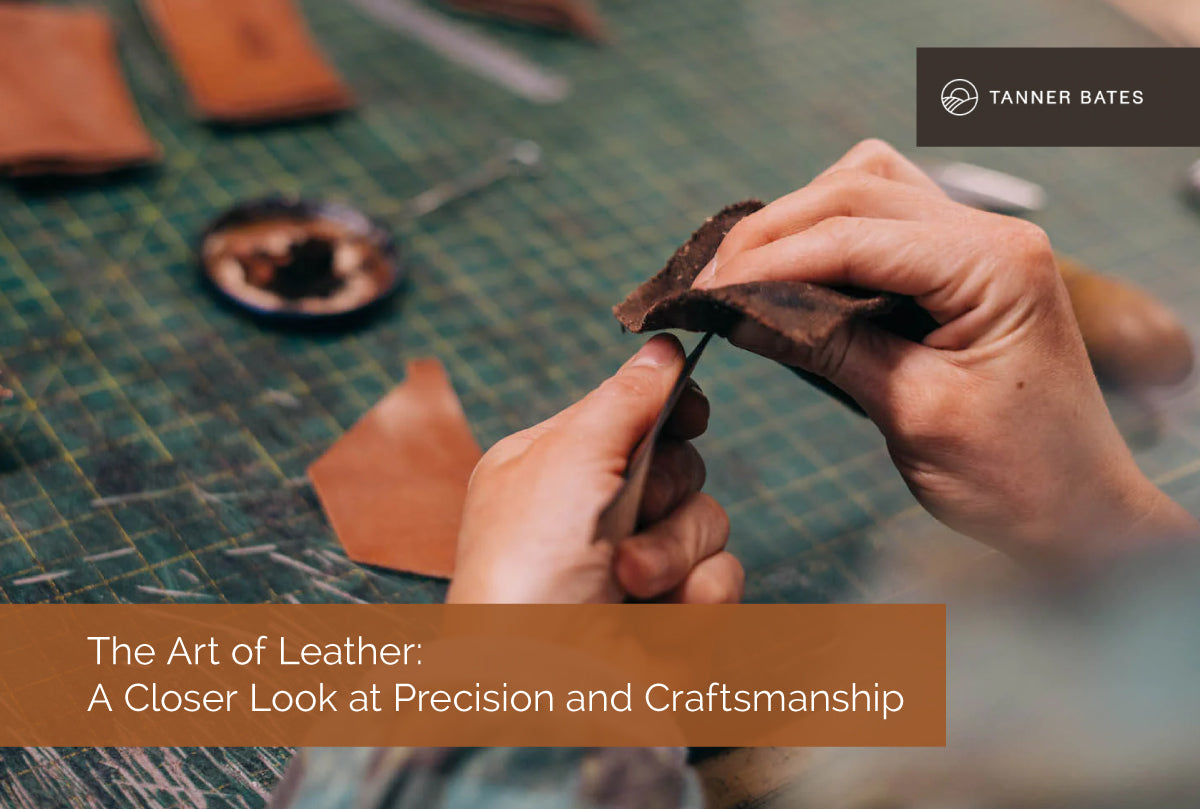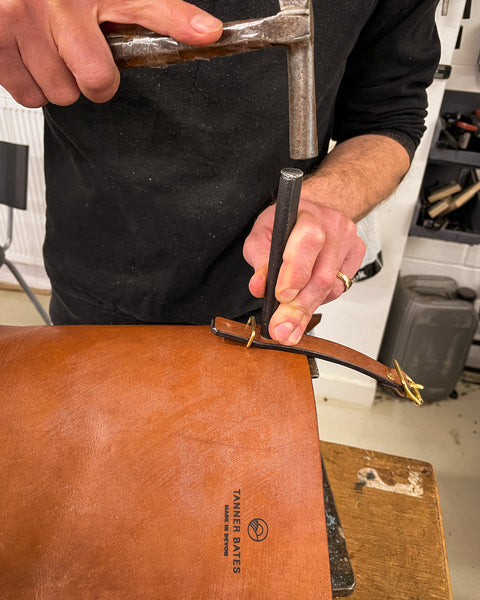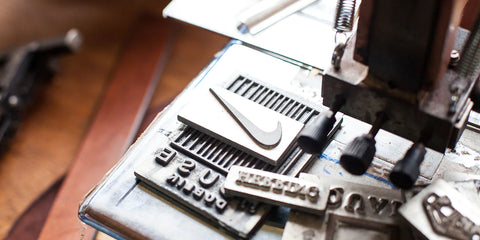November 03, 2023
The Art of Leather: A Closer Look at Precision and Craftsmanship
Leather, a material revered for its durability and aesthetic appeal, has been artistically manipulated by skilled artisans for centuries, leading to the development of a whole new domain - the
Art of Leather. This article delves into the intricate world of
leather craftsmanship, exploring the key aspects contributing to impeccable leather goods. From the selection of high-quality materials to the meticulous attention to detail in construction, the journey of transforming raw hide into an exquisite leather accessory is a testament to the precision and artistic brilliance of the craft.
The Intrinsic Value of Leather
Leather has been an integral part of human civilisation, with its applications spanning from clothing and footwear to armour and bookbinding. Its durability, flexibility, and natural elegance have made leather a highly sought-after material in various industries, particularly fashion and luxury goods. However, the value of leather extends beyond its physical properties. Transforming raw hide into a beautifully finished product demands high skill, patience, and creativity.
Leather - A Timeless Material
The longevity and timeless appeal of leather have made it a staple in the fashion world. Quality leather goods, such as handbags, shoes, and
wallets, serve functional purposes and make a statement about the owner's taste and lifestyle. They are considered investments that can last a lifetime and are often passed down through generations.
The Role of Craftsmanship in Leather Goods
Craftsmanship plays a crucial role in determining the quality and appeal of leather goods. It involves the careful selection of leather, precision in cutting and stitching, and attention to finishing details. When executed to perfection, these elements result in a product that exudes sophistication and class.
Craftsmanship - The Backbone of Leather Artistry
Craftsmanship in leather goods involves a combination of technical skills and artistic sensibilities. It is about understanding the material, knowing its strengths and limitations, and using this knowledge to create a functional and aesthetically pleasing product.
Selection of High-Quality Leather
Selecting high-quality leather is the first step in crafting a leather product. This involves choosing the right type of leather-based on its characteristics, such as texture, strength, and flexibility. Full-grain leather, known for its natural markings and superior strength, is considered the highest quality and most sought-after type.
Precision in Cutting and Stitching
Once the leather has been selected, it is cut into the desired shapes and sizes. This requires high precision to ensure that all pieces fit together perfectly. The next step is stitching, which requires both skill and patience. A well-crafted leather item will have strong and precise stitching that enhances its aesthetic appeal and increases its durability.
The Role of Advanced Machinery and Technology
While traditional craftsmanship remains at the heart of
leather production, advanced machinery and technology have significantly enhanced the process. Such technologies facilitate better accuracy, effectiveness, and uniformity, resulting in improved product quality.
Laser Cutting and Digital Pattern Scanning
The use of laser cutting and digital pattern scanning has revolutionised the way leather is cut and shaped. These technologies allow for highly accurate cuts, improving fit and finish. They also help in reducing waste, contributing to more sustainable production practices.
The Importance of Finishing in Leather Craftsmanship
In leather craftsmanship, finishing refers to the processes carried out after the leather has been cut and stitched. These processes are crucial in enhancing the product's look, feel, and durability.
Edge Burnishing and Colouring
Edge burnishing is a process where the edges of the leather are polished to give them a smooth finish. This improves the product's appearance and protects the edges from wear and tear. Similarly, carefully applying dyes and colours can significantly enhance the product's aesthetic appeal.
Buffing and Polishing
Buffing and polishing processes give the leather a shiny and smooth finish. These processes also help protect the leather from scratches and moisture, extending the product's life.
Quality Assurance - The Final Step
Quality assurance is a crucial aspect of leather craftsmanship. It involves a thorough inspection of the product at various stages of production, ensuring that each leather item meets the highest standards of quality and craftsmanship.
Inspection and Quality Control
Skilled inspectors scrutinise every aspect of the manufacturing process, from material selection and cutting precision to stitching integrity and finishing finesse. Any flaws identified during these inspections are addressed and rectified immediately, ensuring that only flawless products reach the market.
Commitment to Excellence
A commitment to excellence is a common trait among leather artisans. They take great pride in their work and strive to create products that truly reflect their skill and dedication. This commitment to quality and craftsmanship sets genuine leather products apart from mass-produced alternatives.
The Future of Leather Craftsmanship
Despite the advent of mass production and the increasing use of synthetic materials, leather craftsmanship continues to flourish. With a growing appreciation for handmade goods and a renewed focus on sustainability, the future of leather craftsmanship looks promising.
Embracing Innovation
Leather craftsmen are continually seeking ways to innovate and improve. They experiment with new designs, explore alternative materials, and embrace cutting-edge technologies. This spirit of innovation ensures that the art of leather craftsmanship continues to evolve and stay relevant.
Preserving Tradition
While innovation is essential, leather craftsmen also understand the importance of preserving tradition. They respect the time-honoured techniques and skills passed down through generations and strive to keep these traditions alive. This blend of tradition and innovation makes the art of leather craftsmanship genuinely unique.
The Journey of Becoming a Leather Craftsman
Becoming a leather craftsman is a journey that requires dedication, patience, and a deep passion for the craft. It involves learning the skills and techniques of the craft, gaining hands-on experience, and continuously improving and honing one's skills.
Training and Skill Development
Prospective leather craftsmen undergo extensive training to learn the various aspects of the craft. This includes knowing how to select the correct type of leather, mastering cutting and stitching techniques, and understanding the intricacies of finishing and quality control.
Gaining Experience
Apart from training, becoming a skilled leather craftsman also requires practical experience. Aspiring craftsmen often start by working under experienced artisans' guidance, learning the craft's nuances first-hand. Over time, they develop their style and techniques, gradually becoming masters of the craft.
The Art of Leather Engraving
Leather engraving is a specialised skill that adds a unique aesthetic element to leather products. It involves using a laser or other engraving tool to etch intricate designs onto the surface of the leather.
Precision and Detailing
Leather engraving requires a high level of precision and attention to detail. The engraver must carefully control the depth and speed of the engraving tool to ensure that the design is accurately reproduced on the leather surface.
Customisation and Personalisation
Leather engraving offers a great way to customise and personalise leather products. Whether it's a monogram, a logo, or an intricate design, engraving adds a personal touch to the product, making it truly one-of-a-kind.
The Art of Hand Sewn Leather
Hand sewing is a traditional technique used in leather craftsmanship. Despite the availability of modern sewing machines, many craftsmen still prefer hand sewing for its superior strength and durability.
The Saddle Stitch
The saddle stitch is a common hand-sewing technique used in leather craftsmanship. It involves using two needles and a single thread, resulting in a strong, durable seam that can withstand wear and tear.
Precision and Durability
Hand sewing requires a high level of precision and skill. Each stitch must be evenly spaced and the same length to ensure a neat and professional finish. Moreover, the durability of hand-sewn leather products far exceeds that of machine-sewn products.
The Role of Design in Leather Craftsmanship
Design plays a crucial role in leather craftsmanship. This process entails grasping the requirements and inclinations of the intended consumers while devising products that cater to these needs and embody the brand's personality and principles.
Designing for Functionality
When designing a leather product, the craftsman must consider its intended use. This dictates the choice of leather, the design of the product, and the techniques used in its construction. Every element, from the size and shape of the product to the placement of pockets and straps, is carefully considered to ensure functionality.
Designing for Aesthetics
While functionality is essential, aesthetics cannot be overlooked. The design of a leather product should be visually appealing, reflecting the quality of the materials and the craftsman's skill. The colour selection, stitching style, and leather finishing all enhance the item's overall visual appeal.
In summary, the craft of leatherwork encapsulates a mesmerising voyage intertwining technical proficiency, artistic ingenuity, and profound recognition for craftsmanship and quality. Whether it is a handbag, a wallet or a pair of shoes, each leather piece exemplifies the artisan's skill and commitment and mirrors the enduring charm of leather.
For more insights into the world of leather and craftsmanship, visit our
catalogue of genuine leathers and skins, where we guarantee high quality and 100% authenticity. Elevate your style with our exquisite leather products, each meticulously crafted to perfection.
Frequently Asked Questions about Leather Craftsman
Here are a few commonly posed queries concerning the mastery of leather craft.
What is the craftsmanship of leather?
Leather craftsmanship refers to the skill and art of working with leather to create goods like bags, shoes, wallets, clothing, furniture, and accessories. It involves many stages and techniques, some of which include:
1. Cutting: Cut the leather into the needed shapes using a pattern. Precision is crucial at this stage to avoid wasting material and ensure the pieces fit together correctly.
2. Skiving: This is the process of thinning the edges of the leather pieces to fit together seamlessly.
3. Stitching: Craftsmen assemble the leather pieces using different stitches and techniques. It could be done by hand or machine, but hand-stitching is usually preferred for its strength and durability.
4. Edge Finishing: The edges of the product are smoothed, polished, and sometimes dyed for a finished appearance.
5. Tooling or Embossing: Designs might be imprinted or carved into the leather using various tools.
6. Dyeing: The leather is often dyed into different colours using special dyes. It can be a uniform colour or multiple shades for a patina effect.
7. Conditioning: A finish may be applied to the leather to enhance its look, feel, and durability and protect it from water and UV damage.
Each craftsman may have unique methods and techniques, which can take years to master. The attention to detail and high level of craftsmanship are part of what gives handmade leather goods their value and appeal.
What is leather sculpture?
The leather sculpture refers to the art of shaping and moulding leather into three-dimensional forms. Skilled artisans can create objects, from human forms to animals and abstract designs. The process usually involves cutting, shaping, and joining leather - often through techniques like moulding, carving, and tooling - to create the desired shape and detail. Leather sculptures can range from small decorative wall hangings to large installations. Some artists use this technique in mask-making and dimensional wall art. Like other forms of handcrafted leatherwork, leather sculpture often requires significant skill, time, and patience.
What is the origin of leather?
The use of leather originated during prehistoric times when early humans began using animal hides for clothing, footwear, and shelter. The type of animals used varied based on the geographic area and availability.
The process of tanning, used to preserve the leather and make it durable, has been traced back to about 5000 BC with the ancient Egyptians and Sumerians. They employed vegetable tanning, using tree bark and leaves to preserve the leather.
The ancient Greeks further developed leather tanning using certain fats, known as oil tanning. Tools for leatherworking have been found in archaeological excavations, indicating that early civilisations also used leather for various other purposes, such as making containers, boat sails, and military equipment.
Leather has continued to be a helpful material throughout human history in various cultures and civilisations due to its strength, flexibility, and durability. Over the centuries, advancements in tanning processes and craftsmanship have resulted in multiple leather types and products, from footwear and clothing to furniture and accessories.
What is leather known for?
Leather is known for several distinct characteristics and uses:
1. Durability: Leather is a solid material that can withstand considerable wear and tear, making it ideal for goods intended for regular, long-term use.
2. Flexibility: Leather is a versatile substance that can be manipulated into myriad shapes and dimensions. As time passes, leather goods usually adapt to their utilisation, frequently becoming even more cosy and suitable with usage.
3. Versatility: Leather can produce various products, including clothing, footwear, furniture, bags, handbags, belts, wallets, gloves, and more.
4. Luxury: Leather is often associated with luxury and status due to its high quality and the craftsmanship required to work with it.
5. Timelessness: Leather products have a timeless, classic aesthetic appeal, and they often age well, contributing to their longstanding popularity.
6. Easy to Care: If properly cared for, leather can last for many years.
7. Variety: Leather comes in various types (like full-grain, top-grain, genuine leather, etc.), colours, and finishes (from matte to shiny), offering many choices to consumers.
8. Natural Material: Leather is a natural material, which appeals to many people who prefer natural over synthetic. However, its use can raise ethical and sustainability considerations, depending on the provenance and production methods employed – it is always recommended to know where your leather came from and how it was tanned to ensure sustainable practices. Some people however, choose faux/synthetic or plant-based leathers.
Is leather work a craft?
Yes, leatherwork is considered a craft. It involves using hands, special tools, creativity, and knowledge of techniques specific to working with leather, such as cutting, stitching, dyeing, carving, etc. Each piece is often individually crafted and finished, reflecting its maker's attention to detail, skill and craftsmanship.
Whether it's making a
leather bag, shoes, a wallet, or a belt, the process requires a deep understanding of the material and a mastery of the skills involved. Many artisans and hobbyists alike find leatherwork a rewarding craft. Its products are applicable and can also be seen as works of art, reflecting personal creativity and style.
What can you craft with leather?
There's a wide variety of items that can be made from leather. Here are just a few examples:
1. Bags: This includes small clutches, handbags, backpacks, and luxury luggage.
2. Wallets: Both men's and women's wallets can be crafted from leather.
3. Belts: Leather belts are a classic accessory.
4. Shoes: From dress shoes and casual loafers to sturdy work boots, leather is a popular material for footwear.
5. Jackets and Clothing: Leather jackets are a fashion staple, and leather can also be used to create pants, dresses, and other types of clothing.
6. Furniture: Leather can be used for sofas, chairs, and other furniture.
7. Jewellery: Leather can be utilised to craft bracelets, necklaces, earrings, and various other forms of jewellery.
8. Bookbinding: Leather has historically been used for the covers of books.
9. Watch Bands: Many high-quality timepieces have leather bands.
10. Tech Accessories include phone cases, camera straps, and laptop sleeves.
11. Home Décor: Leather can make picture frames, basket handles, lampshades, and more.
12. Craft Supplies: Leather offcuts can be used in crafting for various purposes.
The possibilities are only limited by imagination and crafting ability. Many people find working with leather a rewarding hobby or even a career.
Leave a comment
Comments will be approved before showing up.








